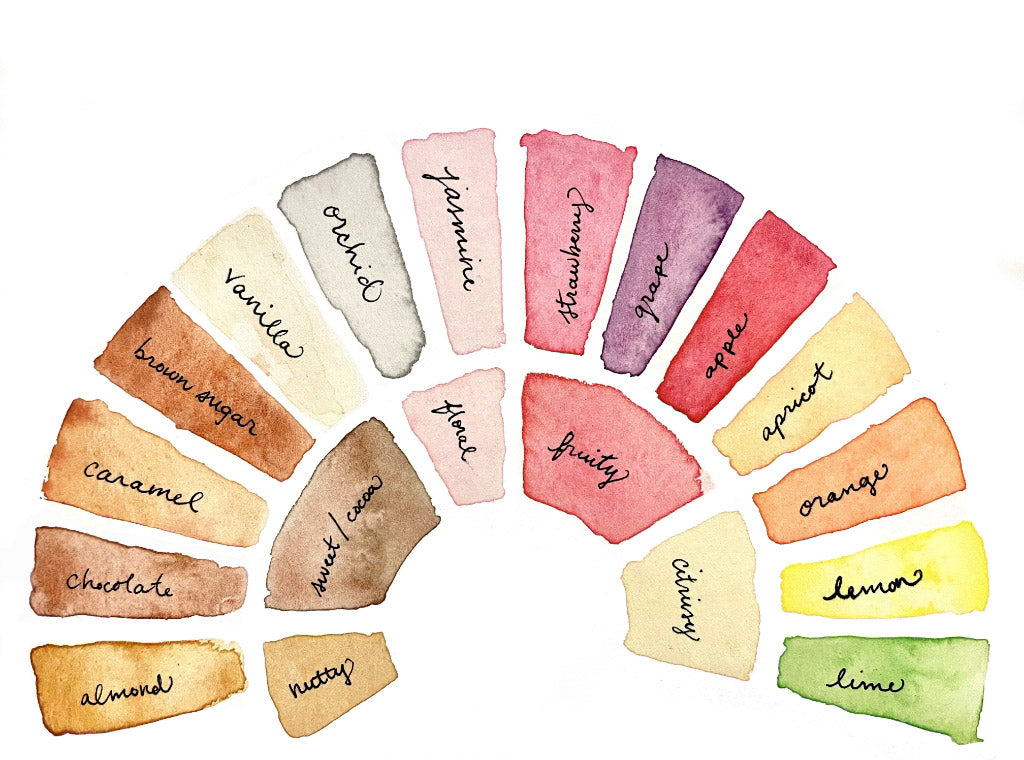
The Terminology of Coffee Tasting Notes
THE LANGUAGE OF COFFEE
“Orange peel,” “dark chocolate,” “white orchid.” What do the tasting notes on coffee bags actually mean? Tasting—or flavor—notes are not added flavors but are inherent to the coffee bean itself. So where do these flavors come from if they aren’t added to the beans?
Coffee flavor comes from its incredibly vast and diverse arrangement of chemical compounds. It is perhaps one of the most chemically complex things we consume, even beating out wine, with around 1200 volatile compounds making up a coffee’s flavor, aroma, and body. Many of these molecules are present in foods we eat and things we smell, and they send similar signals to our brains when we drink them in coffee. When you drink our limited release Ethiopian Super Natural, you might come across ethyl-3-methylbutanoate, a compound also found in blueberries. It will tickle your brain in the same way, evoking a blueberry flavor in a coffee that has never touched actual blueberries.
Every step of a coffee’s life cycle changes and contributes to flavor. How high a coffee is grown, what minerals are present in the soils, and how a coffee is processed will all contribute unique chemical compounds. Likewise, roasting plays a huge role in unlocking molecules stowed away in green (raw) coffee beans. Heat bursts open the cellular structure of the bean, increasing its complexity and creating sweetness and depth of flavor. Brewing also introduces different notes depending on how the coffee is extracted. The same coffee roasted or brewed in varying ways can change it significantly.
It is possible to parse out and identify these compounds with chemical analysis. However, if you haven’t tasted a coffee, no amount of mass spectrometer or gas chromatography readings could tell you what it is like to drink it. The human brain is a far more nuanced analysis system than any machine we’ve yet invented. This is why we still rely on specialized tasters to assess coffee quality and determine a coffee’s flavor profile.
Being able to discern the quality of a coffee is integral not only to roasters but to producers as well. Producers will be able to earn a higher price for their coffee when they know that it is of a superior caliber. But to determine if a coffee is good, bad, or somewhere in between, everyone has to agree on a standard, a difficult thing to achieve in an industry that spans the globe.
To keep the entire coffee industry on the same page, standardized lexicons and flavor wheels have been developed by sensory scientists and coffee experts to record and organize the attributes and flavors of coffee. In 2012, Peet’s helped to found World Coffee Research, a non-profit research organization dedicated to coffee quality and climate resilience. WCR’s Sensory Lexicon, a tool for categorizing and measuring coffee’s sensorial qualities, was used to create the Specialty Coffee Association’s Coffee Taster’s Flavor Wheel, which is now used as a standard throughout the industry. The Wheel and Sensory Lexicon provide a common language for all coffee tasters, allowing everyone to calibrate on flavor profiles and coffee quality.
Of course, taste is dependent on personal experience. If I’ve never eaten marzipan or lychee fruit, then those tasting notes are irrelevant to me. Since not everyone has tasted the same things, flavor categories like “fruity” “floral” “cocoa/nutty” and “spice” are built into the Wheel to account for the diversity of taste experience.
Every individual’s unique experience of the world contributes to what they taste and what memories the molecule shapes unlock when we take a sip of coffee. In this way, flavor notes can indeed seem more like metaphor or poetry, but because trained tasters are interpreting the chemical makeup of a coffee when describing it, flavor notes have a scientifically objective foundation. Sometimes telling a story can convey an idea better than a research paper, and likewise, describing something as “plush with notes of juicy green apple” expresses more than “trans 2-hexenal,” a molecule found in green apples. Both are important and communicate different parts of a whole.
It is this harmonious intersection of objectivity and subjectivity, of describing the indescribable, communicating our experiences with one another and sharing in them, that makes every sip of coffee fascinating and uniquely human.
-Author and Illustrator Alysse Wishart is Peet's Coffee Quality Specialist, Coffee Department


